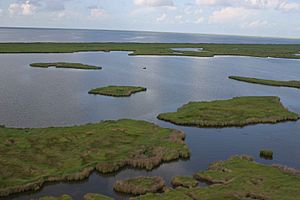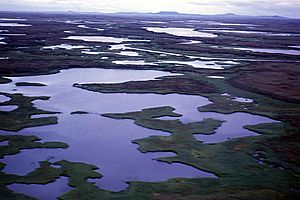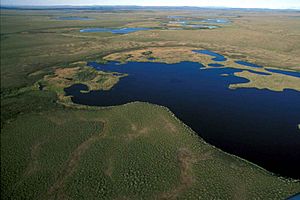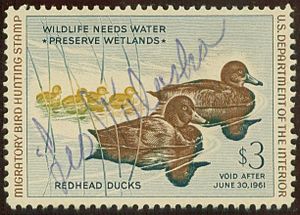Emergency Wetlands Resources Act facts for kids
 |
|
| Long title | Emergency Wetlands Resources Act of 1986 was enacted to protect and promote conservation of the Nations wetlands and establish National Wildlife Refuges for waterfowl. |
|---|---|
| Acronyms (colloquial) | EWRA |
| Enacted by | the 99th United States Congress |
| Effective | November 10, 1986 |
| Citations | |
| Public law | P.L. 99-645 |
| Statutes at Large | 100 Stat. 3582 |
| Codification | |
| U.S.C. sections created | 16 U.S.C. § 3901-3902, § 3911-3912, § 3921-3932, & § 3931-3932 |
| Legislative history | |
|
|
| Major amendments | |
| P.L. 100-418, P.L. 101-233, P.L. 102-440, P.L. 103-437, P.L. 104-4, P.L. 104-28, P.L. 105-18, P.L. 105-83, P.L. 108-447 | |
The Emergency Wetlands Resources Act of 1986 is a United States federal law that became active on November 10, 1986. Before this law, the government was not allowed to buy wetlands. This Act changed that, allowing the Secretary of the Interior to use money from the Land and Water Conservation Fund (LWCF) to buy wetlands.
The Act also created a National Wetlands Priority Conservation Plan. This plan made sure that all states included wetlands in their outdoor recreation plans. It also moved money from import taxes on weapons and ammunition into the Migratory Bird Conservation Fund. The main goal of this law was to protect wetlands and help the United States keep its promises in international agreements about migratory birds.
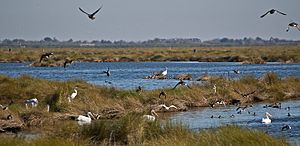
This law also extended the Wetlands Loan Act of 1961. It meant that loans given for wetlands would be forgiven, and funding would continue until September 30, 1988. The Act also required the Secretary of the Interior to report to the United States Congress about any wetlands that were lost. These reports had to explain if government programs or rules caused any of these losses.
The Secretary also had to finish mapping all wetlands in the United States by September 30, 1990. This included both the main part of the U.S. and other areas. A full inventory of all National Wetlands was to be done by September 30, 1998, and updated every ten years after that.
The Act also allowed National Wildlife Refuges to charge entrance fees. It also officially created the Bayou Sauvage National Wildlife Refuge in Louisiana. Money from these fees was split: 70% went to the Migratory Bird Conservation Fund, and 30% was used to maintain and operate the refuges. The price of Federal Duck Stamps also went up from $7.50 to $15.00 by 1991. These stamps, first created in 1929, help raise money for bird conservation.
Later changes to the Act allowed some refuges to keep 80% of the fees they collected. This was part of "Demonstration Fee programs" and changed the original 70/30 split.
Contents
Why Wetlands are Important
This part of the law explains why wetlands are so important. Congress found that wetlands are vital for the country's economy, health, safety, and for people's recreation. They also provide major benefits like:
- Helping with our food supply.
- Improving water quality and supply.
- Controlling floods.
- Providing homes for fish, wildlife, and plants.
Protecting wetlands is also important for migratory birds. The U.S. has agreements with countries like Canada, Mexico, Japan, and the U.S.S.R. to protect these birds. Wetlands are key places for birds to breed, spend winter, and rest during their long journeys. Protecting them helps keep bird populations healthy.
Because wetlands are so important for society and the environment, the main goal of this Act is to protect and save them. This ensures that wetlands are not damaged further and continue to provide their many benefits. Both federal and state programs work together to achieve this.
How Money Helps Refuges and Birds
This section of the Act explains how money is collected and used for wildlife refuges and bird conservation. While the Land and Water Conservation Fund usually pays for buying wetlands, extra money is needed to run and maintain the refuges.
The Secretary of the Interior was given the power to charge entrance fees at National Wildlife Refuges. Money collected from these fees was divided:
- 30% was used by the Secretary to cover the costs of collecting fees, maintaining, and operating the refuges.
- 70% was put into the Migratory Bird Conservation Fund.
Also, money equal to all import taxes collected on weapons and ammunition is paid every three months into the Migratory Bird Conservation Fund. This started after November 10, 1986.
Buying and Protecting Wetlands
This part of the Act set up the National Wetlands Priority Conservation Plan. This plan helps decide which wetlands should be bought by federal and state governments.
The Secretary of the Interior created this plan, which describes different types of wetlands and areas that should be considered for purchase. The plan is regularly reviewed and updated. When creating the plan, the Secretary considers:
- How many of each wetland type still exist compared to long ago.
- How fast different types of wetlands are being lost.
- Which wetlands are important for all wildlife, including threatened and endangered species, migratory birds, and local animals.
- Wetlands that help with sport and commercial fisheries, water quality, flood control, and outdoor recreation.
The Act also says that the federal government can only buy wetlands that are not already covered by the Migratory Bird Conservation Act of 1929. All purchases must follow the rules set out in the conservation plan.
Importantly, the Act also said that the government cannot use "Eminent Domain" to take wetlands that are used for ranching, farming, or conservation. Eminent Domain is when the government forces someone to sell their property for public use.
Mapping and Reporting on Wetlands
This section of the Act focuses on mapping all wetlands and reporting on their status. The Secretary of the Interior and the Director of the United States Fish and Wildlife Service were told to continue the National Wetlands Inventory Project.
- By September 30, 1988, maps for all U.S. coastal zones, major river floodplains, and prairie pothole regions had to be finished.
- By September 30, 1998, maps for the rest of the main United States had to be completed.
- Maps for other U.S. territories had to be done two years later.
Reports updating the "Status and Trends of Wetlands and Deepwater Habitat" were to begin by September 30, 1990, and be presented every 10 years. All wetland maps were to be made digital, creating a database for easy access.
The Secretary of Agriculture and the Secretary of the Interior work together to prepare and submit reports to Congress. These reports must explain:
- Why wetlands are being destroyed, damaged, protected, or improved.
- How much federal money is spent on activities that affect wetlands, whether positively or negatively.


